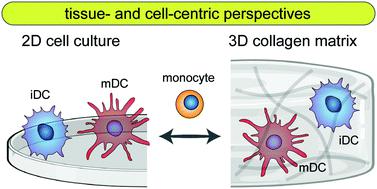当前位置:
X-MOL 学术
›
Biomater. Sci.
›
论文详情
Our official English website, www.x-mol.net, welcomes your feedback! (Note: you will need to create a separate account there.)
Dendritic cell immune potency on 2D and in 3D collagen matrices.
Biomaterials Science ( IF 6.6 ) Pub Date : 2020-07-31 , DOI: 10.1039/d0bm01141j Jiranuwat Sapudom 1 , Aseel Alatoom 1 , Walaa K E Mohamed 1 , Anna Garcia-Sabaté 1 , Ian McBain 1 , Rasha A Nasser 2 , Jeremy C M Teo 3
Biomaterials Science ( IF 6.6 ) Pub Date : 2020-07-31 , DOI: 10.1039/d0bm01141j Jiranuwat Sapudom 1 , Aseel Alatoom 1 , Walaa K E Mohamed 1 , Anna Garcia-Sabaté 1 , Ian McBain 1 , Rasha A Nasser 2 , Jeremy C M Teo 3
Affiliation

|
Dendritic cells (DCs) are antigen-presenting cells capable of either activating the immune response or inducing and maintaining immune tolerance. Understanding how biophysical properties affect DC behaviors will provide insight into the biology of a DC and its applications. In this work, we studied how cell culture dimensionality (two-dimensional (2D) and three-dimensional (3D)), and matrix density of 3D collagen matrices modulate differentiation and functions of DCs. Besides, we aimed to point out the different conceptual perspectives in modern immunological research, namely tissue-centric and cell-centric perspectives. The tissue-centric perspective intends to reveal how specific microenvironments dictate DC differentiation and in turn modulate DC functionalities, while the cell-centric perspective aims to demonstrate how pre-differentiated DCs behave in specific microenvironments. DC plasticity was characterized in terms of cell surface markers and cytokine secretion profiles. Subsequently, antigen internalization and T cell activation were quantified to demonstrate the cellular functions of immature DCs (iDCs) and mature DCs (mDCs), respectively. In the tissue-centric perspective, we found that expressed surface markers and secreted cytokines of both iDCs and mDCs are generally higher in 2D culture, while they are regulated by matrix density in 3D culture. In contrast, in the cell-centric perspective, we found enhanced expression of cell surface markers as well as distinct cytokine secretion profiles in both iDCs and mDCs. By analyzing cellular functions of cells in the tissue-centric perspective, we found matrix density dependence in antigen uptake by iDCs, as well as on mDC-mediated T cell proliferation in 3D cell culture. On the other hand, in the cell-centric perspective, both iDCs and mDCs appeared to lose their functional potentials to internalization antigen and T cell stimulation. Additionally, mDCs from tissue- and cell-centric perspectives modulated T cell differentiation by their distinct cytokine secretion profiles towards Th1 and Th17, respectively. In sum, our work emphasizes the importance of dimensionality, as well as collagen fibrillar density in the regulation of the immune response of DCs. Besides this, we demonstrated that the conceptual perspective of the experimental design could be an essential key point in research in immune cell–material interactions and biomaterial-based disease models of immunity.
中文翻译:

树突状细胞对2D和3D胶原蛋白基质的免疫力。
树突细胞(DC)是能够激活免疫反应或诱导和维持免疫耐受的抗原呈递细胞。了解生物物理特性如何影响DC行为将提供对DC生物学及其应用的深入了解。在这项工作中,我们研究了细胞培养的维数(二维(2D)和三维(3D))以及3D胶原蛋白基质的基质密度如何调节DC的分化和功能。此外,我们旨在指出现代免疫学研究中不同的概念观点,即以组织为中心和以细胞为中心的观点。以组织为中心的观点旨在揭示特定的微环境如何决定DC分化并进而调节DC功能,而以细胞为中心的观点旨在证明预分化DC在特定微环境中的行为。DC可塑性根据细胞表面标志物和细胞因子分泌特征来表征。随后,量化了抗原内在化和T细胞活化,以分别证明未成熟DC(iDC)和成熟DC(mDC)的细胞功能。在以组织为中心的角度,我们发现iDC和mDC的表达表面标志物和分泌的细胞因子一般在2D培养中较高,而在3D培养中则受基质密度调节。相比之下,以细胞为中心的观点,我们发现iDC和mDC中细胞表面标志物的表达增强以及独特的细胞因子分泌谱。通过以组织为中心的角度分析细胞的细胞功能,我们发现基质密度依赖iDC吸收抗原,以及3D细胞培养物中mDC介导的T细胞增殖。另一方面,从以细胞为中心的角度来看,iDC和mDC似乎都丧失了对内在化抗原和T细胞刺激的功能潜力。此外,从组织和细胞中心的角度来看,mDC通过分别朝向Th1和Th17的不同细胞因子分泌曲线来调节T细胞分化。总而言之,我们的工作强调了维数的重要性以及胶原纤维密度在调节DC免疫应答中的重要性。除此之外,我们证明了实验设计的概念性观点可能是研究免疫细胞-材料相互作用和免疫性基于生物材料的疾病模型中的关键点。
更新日期:2020-09-15
中文翻译:

树突状细胞对2D和3D胶原蛋白基质的免疫力。
树突细胞(DC)是能够激活免疫反应或诱导和维持免疫耐受的抗原呈递细胞。了解生物物理特性如何影响DC行为将提供对DC生物学及其应用的深入了解。在这项工作中,我们研究了细胞培养的维数(二维(2D)和三维(3D))以及3D胶原蛋白基质的基质密度如何调节DC的分化和功能。此外,我们旨在指出现代免疫学研究中不同的概念观点,即以组织为中心和以细胞为中心的观点。以组织为中心的观点旨在揭示特定的微环境如何决定DC分化并进而调节DC功能,而以细胞为中心的观点旨在证明预分化DC在特定微环境中的行为。DC可塑性根据细胞表面标志物和细胞因子分泌特征来表征。随后,量化了抗原内在化和T细胞活化,以分别证明未成熟DC(iDC)和成熟DC(mDC)的细胞功能。在以组织为中心的角度,我们发现iDC和mDC的表达表面标志物和分泌的细胞因子一般在2D培养中较高,而在3D培养中则受基质密度调节。相比之下,以细胞为中心的观点,我们发现iDC和mDC中细胞表面标志物的表达增强以及独特的细胞因子分泌谱。通过以组织为中心的角度分析细胞的细胞功能,我们发现基质密度依赖iDC吸收抗原,以及3D细胞培养物中mDC介导的T细胞增殖。另一方面,从以细胞为中心的角度来看,iDC和mDC似乎都丧失了对内在化抗原和T细胞刺激的功能潜力。此外,从组织和细胞中心的角度来看,mDC通过分别朝向Th1和Th17的不同细胞因子分泌曲线来调节T细胞分化。总而言之,我们的工作强调了维数的重要性以及胶原纤维密度在调节DC免疫应答中的重要性。除此之外,我们证明了实验设计的概念性观点可能是研究免疫细胞-材料相互作用和免疫性基于生物材料的疾病模型中的关键点。



























 京公网安备 11010802027423号
京公网安备 11010802027423号